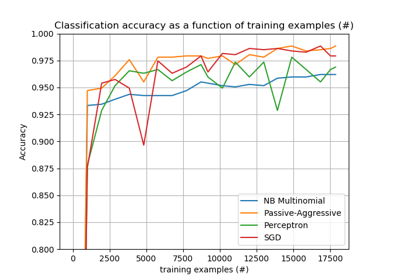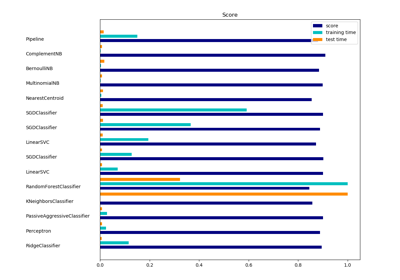sklearn.feature_extraction.text.HashingVectorizer¶
-
class
sklearn.feature_extraction.text.HashingVectorizer(input=’content’, encoding=’utf-8’, decode_error=’strict’, strip_accents=None, lowercase=True, preprocessor=None, tokenizer=None, stop_words=None, token_pattern=’(?u)\b\w\w+\b’, ngram_range=(1, 1), analyzer=’word’, n_features=1048576, binary=False, norm=’l2’, alternate_sign=True, non_negative=False, dtype=<class ‘numpy.float64’>)[source]¶ Convert a collection of text documents to a matrix of token occurrences
It turns a collection of text documents into a scipy.sparse matrix holding token occurrence counts (or binary occurrence information), possibly normalized as token frequencies if norm=’l1’ or projected on the euclidean unit sphere if norm=’l2’.
This text vectorizer implementation uses the hashing trick to find the token string name to feature integer index mapping.
This strategy has several advantages:
- it is very low memory scalable to large datasets as there is no need to store a vocabulary dictionary in memory
- it is fast to pickle and un-pickle as it holds no state besides the constructor parameters
- it can be used in a streaming (partial fit) or parallel pipeline as there is no state computed during fit.
There are also a couple of cons (vs using a CountVectorizer with an in-memory vocabulary):
- there is no way to compute the inverse transform (from feature indices to string feature names) which can be a problem when trying to introspect which features are most important to a model.
- there can be collisions: distinct tokens can be mapped to the same feature index. However in practice this is rarely an issue if n_features is large enough (e.g. 2 ** 18 for text classification problems).
- no IDF weighting as this would render the transformer stateful.
The hash function employed is the signed 32-bit version of Murmurhash3.
Read more in the User Guide.
Parameters: - input : string {‘filename’, ‘file’, ‘content’}
If ‘filename’, the sequence passed as an argument to fit is expected to be a list of filenames that need reading to fetch the raw content to analyze.
If ‘file’, the sequence items must have a ‘read’ method (file-like object) that is called to fetch the bytes in memory.
Otherwise the input is expected to be the sequence strings or bytes items are expected to be analyzed directly.
- encoding : string, default=’utf-8’
If bytes or files are given to analyze, this encoding is used to decode.
- decode_error : {‘strict’, ‘ignore’, ‘replace’}
Instruction on what to do if a byte sequence is given to analyze that contains characters not of the given encoding. By default, it is ‘strict’, meaning that a UnicodeDecodeError will be raised. Other values are ‘ignore’ and ‘replace’.
- strip_accents : {‘ascii’, ‘unicode’, None}
Remove accents and perform other character normalization during the preprocessing step. ‘ascii’ is a fast method that only works on characters that have an direct ASCII mapping. ‘unicode’ is a slightly slower method that works on any characters. None (default) does nothing.
Both ‘ascii’ and ‘unicode’ use NFKD normalization from
unicodedata.normalize.- lowercase : boolean, default=True
Convert all characters to lowercase before tokenizing.
- preprocessor : callable or None (default)
Override the preprocessing (string transformation) stage while preserving the tokenizing and n-grams generation steps.
- tokenizer : callable or None (default)
Override the string tokenization step while preserving the preprocessing and n-grams generation steps. Only applies if
analyzer == 'word'.- stop_words : string {‘english’}, list, or None (default)
If ‘english’, a built-in stop word list for English is used. There are several known issues with ‘english’ and you should consider an alternative (see Using stop words).
If a list, that list is assumed to contain stop words, all of which will be removed from the resulting tokens. Only applies if
analyzer == 'word'.- token_pattern : string
Regular expression denoting what constitutes a “token”, only used if
analyzer == 'word'. The default regexp selects tokens of 2 or more alphanumeric characters (punctuation is completely ignored and always treated as a token separator).- ngram_range : tuple (min_n, max_n), default=(1, 1)
The lower and upper boundary of the range of n-values for different n-grams to be extracted. All values of n such that min_n <= n <= max_n will be used.
- analyzer : string, {‘word’, ‘char’, ‘char_wb’} or callable
Whether the feature should be made of word or character n-grams. Option ‘char_wb’ creates character n-grams only from text inside word boundaries; n-grams at the edges of words are padded with space.
If a callable is passed it is used to extract the sequence of features out of the raw, unprocessed input.
- n_features : integer, default=(2 ** 20)
The number of features (columns) in the output matrices. Small numbers of features are likely to cause hash collisions, but large numbers will cause larger coefficient dimensions in linear learners.
- binary : boolean, default=False.
If True, all non zero counts are set to 1. This is useful for discrete probabilistic models that model binary events rather than integer counts.
- norm : ‘l1’, ‘l2’ or None, optional
Norm used to normalize term vectors. None for no normalization.
- alternate_sign : boolean, optional, default True
When True, an alternating sign is added to the features as to approximately conserve the inner product in the hashed space even for small n_features. This approach is similar to sparse random projection.
New in version 0.19.
- non_negative : boolean, optional, default False
When True, an absolute value is applied to the features matrix prior to returning it. When used in conjunction with alternate_sign=True, this significantly reduces the inner product preservation property.
Deprecated since version 0.19: This option will be removed in 0.21.
- dtype : type, optional
Type of the matrix returned by fit_transform() or transform().
See also
Examples
>>> from sklearn.feature_extraction.text import HashingVectorizer >>> corpus = [ ... 'This is the first document.', ... 'This document is the second document.', ... 'And this is the third one.', ... 'Is this the first document?', ... ] >>> vectorizer = HashingVectorizer(n_features=2**4) >>> X = vectorizer.fit_transform(corpus) >>> print(X.shape) (4, 16)
Methods
build_analyzer()Return a callable that handles preprocessing and tokenization build_preprocessor()Return a function to preprocess the text before tokenization build_tokenizer()Return a function that splits a string into a sequence of tokens decode(doc)Decode the input into a string of unicode symbols fit(X[, y])Does nothing: this transformer is stateless. fit_transform(X[, y])Transform a sequence of documents to a document-term matrix. get_params([deep])Get parameters for this estimator. get_stop_words()Build or fetch the effective stop words list partial_fit(X[, y])Does nothing: this transformer is stateless. set_params(**params)Set the parameters of this estimator. transform(X)Transform a sequence of documents to a document-term matrix. -
__init__(input=’content’, encoding=’utf-8’, decode_error=’strict’, strip_accents=None, lowercase=True, preprocessor=None, tokenizer=None, stop_words=None, token_pattern=’(?u)\b\w\w+\b’, ngram_range=(1, 1), analyzer=’word’, n_features=1048576, binary=False, norm=’l2’, alternate_sign=True, non_negative=False, dtype=<class ‘numpy.float64’>)[source]¶
-
decode(doc)[source]¶ Decode the input into a string of unicode symbols
The decoding strategy depends on the vectorizer parameters.
Parameters: - doc : string
The string to decode
-
fit(X, y=None)[source]¶ Does nothing: this transformer is stateless.
Parameters: - X : array-like, shape [n_samples, n_features]
Training data.
-
fit_transform(X, y=None)[source]¶ Transform a sequence of documents to a document-term matrix.
Parameters: - X : iterable over raw text documents, length = n_samples
Samples. Each sample must be a text document (either bytes or unicode strings, file name or file object depending on the constructor argument) which will be tokenized and hashed.
- y : any
Ignored. This parameter exists only for compatibility with sklearn.pipeline.Pipeline.
Returns: - X : scipy.sparse matrix, shape = (n_samples, self.n_features)
Document-term matrix.
-
get_params(deep=True)[source]¶ Get parameters for this estimator.
Parameters: - deep : boolean, optional
If True, will return the parameters for this estimator and contained subobjects that are estimators.
Returns: - params : mapping of string to any
Parameter names mapped to their values.
-
partial_fit(X, y=None)[source]¶ Does nothing: this transformer is stateless.
This method is just there to mark the fact that this transformer can work in a streaming setup.
Parameters: - X : array-like, shape [n_samples, n_features]
Training data.
-
set_params(**params)[source]¶ Set the parameters of this estimator.
The method works on simple estimators as well as on nested objects (such as pipelines). The latter have parameters of the form
<component>__<parameter>so that it’s possible to update each component of a nested object.Returns: - self
-
transform(X)[source]¶ Transform a sequence of documents to a document-term matrix.
Parameters: - X : iterable over raw text documents, length = n_samples
Samples. Each sample must be a text document (either bytes or unicode strings, file name or file object depending on the constructor argument) which will be tokenized and hashed.
Returns: - X : scipy.sparse matrix, shape = (n_samples, self.n_features)
Document-term matrix.




